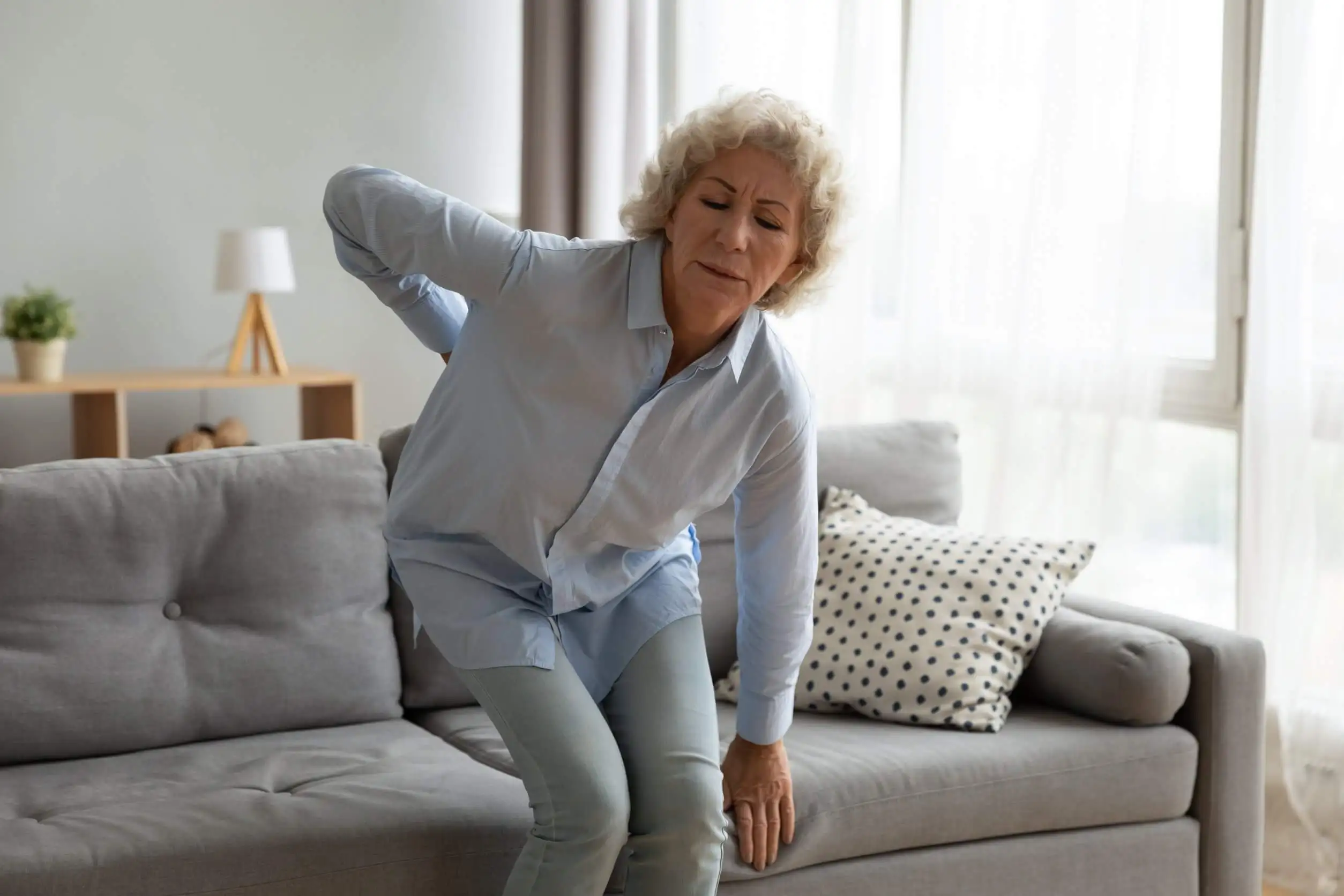Can Abdominal Crunches Hurt Your Back? Here's What the Research Says


Written and verified by the doctor Leonardo Biolatto
The abdominal crunch has strong detractors because many argue that it can hurt the back. In fact, it’s easy to notice that fewer and fewer personal trainers are including it in their routines.
The choice has been made to replace the work of this classic movement with isometric contractions that are performed while toning the upper or lower limbs. In other words, we’re urged to keep our abdomen tightened during squats, low rowing, or military presses. In theory, this way we protect the spine and get the same results.
However, not everyone agrees with this. In fact, the abdominal crunch may not injure the back if performed with some caution and without overdoing it. Let’s see what sports science has to say about it.
What is the abdominal crunch?
The abdominal crunch is the classic exercise that we’ve all performed or seen performed. The person lays on the floor, flexes his or her legs, and lifts his r her scapulae to reach about 30 degrees with his or back in order to touch his knees with his or her elbows.
This is an optimal movement to tone the anterior rectus abdominis muscle. This is located in the front area of the core and is responsible for the aesthetic six-pack. Specifically, this exercise focuses on the upper part of this muscle. It also activates, although to a lesser extent, the obliques, which are on the sides of the belly.
Beyond the fact that the abdominal crunch may or may not hurt the back, variants have appeared over time. It can be performed on a medicine ball, adding a swing when lifting to improve the activation of the obliques, or carrying weight in your hands with dumbbells.
What are the risks?
All muscle toning exercises have risks. Most of them appear when we execute an incorrect technique or if we prepare to do them without warming up beforehand.
The abdominal crunch isn’t free from this reality, and there has always been controversy about its effect on the back. Repeatedly bending the spine on a hard surface does not seem to be healthy biomechanics.
Since 1989 there have been scientific studies analyzing the effect of flexion-extension on the vertebrae. Continuous repetition of the movement seems to increase the accumulated stress on the intervertebral disc, which is a gel-like substance essential for the spine to bend.
Analyses with small groups of human volunteers detected migration of the intervertebral disc when bending the spine at different angles. However, there was no stronger evidence for this. At least until 2007, when the research was able to certify that certain body postures are capable of shifting the intervertebral disc into abnormal positions.
So what does this theory postulate? Well, it means that repeated abdominal crunching can damage the back by displacing the intervertebral discs, favoring the appearance of a herniated disc.

The issue is not so clear
Despite the evidence we already mentioned, a 2016 publication allows itself to differ. According to the authors, there is no concrete research data analyzing the performance of the abdominal crunch in humans and the hypothesis that it can hurt the back.
The scientific studies were conducted in other contexts or with animals. No one has recorded herniated discs derived from classic abdominal crunches.
There are theories based on the form of action of the anterior rectus abdominis muscle. However, they are theories and are not effectively proven.
For example, Stuart MacGill, a renowned doctor in the world of sports science, has his own view on the abdominal crunch and the ability to injure the back. For him, the ability of the spine to withstand flexions and extensions is limited, since it’s an unnatural and non-functional movement.
That is, the rectus abdominis is a muscle for the stability of the core, not for repeated folding in on itself. In the course of a day, we bend the spine many times, but we do not do it to a high degree or with the continuous need for our hands to touch our knees.
That is why, according to him, the abdominal crunch damages the back if the recommended repetitions are exceeded. The spine would reach a limit and, after exceeding it, the tissues would have no way to withstand the pressure.
You may also like to read: Exercises for Abdominals without Hurting Your Back
What if we don’t exceed the limit?
The theory that the spine supports a specific amount of flexion cycles is not absolute. In any case, if we refer to physical exercise, there will be times of rest and even days between crunches.
Thus, tissues have the ability to regenerate. Therefore, the accumulation of supposed damage would not be so harmful.
In addition, if we don’t exceed the recommended amount of crunches for a day or a week, we will also have the protective effect of intra-abdominal pressure working on our favor. By bending the spine in the exercise, the pressure inside the belly increases, and that increase, according to studies, reduces the force that the tissues of the back have to support.
Are there people more susceptible to damaging their backs with abdominal crunches?
Most training exercises have contraindications. There are people who should not perform certain movements because they are more likely to injure themselves doing it.
In the case of the abdominal crunch, there are situations that warrant the consideration of special care:
- Small-framed women and children may be more at risk. One study found that short stature promotes unnatural movements when exercising the abdominals, which unbalances the forces.
- People with osteoporosis or osteopenia. The finding of lesions in the vertebrae of women with osteoporosis when flexing the belly raises a red flag about the effect on the spine and the possibility of increasing the risk of fractures.
- Patients with disc herniation. The existence of a herniated disc with pain contraindicates abdominal crunches.

What is the suggested limit of repetitions?
A person with no health conditions in their spine could perform abdominal crunches up to a certain limit. How many repetitions to be safe?
According to Contreras and Schoenfeld, each day of training should not exceed 60 repetitions. Of course, if you are just starting out, this value will be lower, perhaps half, until you improve your toning and can gradually increase the series. The rest between one abdominal session and another is also relevant.
We have known for almost 30 years that the protein synthesis of muscle recovery requires about 48 hours. So, leaving intermediate days without crunches would be the basic and optimal strategy to avoid overloading the rectus abdominis.
Also, what time of day should you do them? It seems that it’s best to avoid the morning and the moments immediately after office hours. The spine is more susceptible to damage to the intervertebral discs when we have spent several hours in a lying or sitting position.
Read more: Maria Pedraza’s Workout Routine to Maintain a Slim Figure
Should I eliminate traditional crunches from my routine?
Fear of hurting the back with the abdominal crunch may be reason enough to remove it from the routine. However, you don’t need to abandon them altogether.
An adult person, of average build, with no history of spinal problems, can do up to 60 repetitions with a day’s rest between each session.
It’s also possible to modify some features of traditional exercise to reduce risk. For example, the hands can be placed under the lower back to preserve the normal curvature of the spine when lifting.
The incorporation of the medicine ball is also a good idea. This device partially protects the spine and changes the activation of the abdominal muscles, while promoting core stability.
Regarding the angle, it’s not necessary to complete a total flexion. If we do not exceed 30 degrees when bending, it will be sufficient just the same, being able to use a range of just 10-15 degrees. There are many ways to promote the stability of the central part of our body.
If you consult with training professionals, they will know how to guide you to combine different movements that contribute to this end. What you should never do is fall for the popular viral challenges on the Internet, which encourage you to perform 100 or 200 crunches every day for a month. In this case, science has no doubts: you will end up injuring your back.
All cited sources were thoroughly reviewed by our team to ensure their quality, reliability, currency, and validity. The bibliography of this article was considered reliable and of academic or scientific accuracy.
- Alexander, L. A., Hancock, E., Agouris, I., Smith, F. W., & MacSween, A. (2007). The response of the nucleus pulposus of the lumbar intervertebral discs to functionally loaded positions. Spine, 32(14), 1508–1512. https://doi.org/10.1097/BRS.0b013e318067dccb
- Callaghan, J. P., & McGill, S. M. (2001). Low back joint loading and kinematics during standing and unsupported sitting. Ergonomics, 44(3), 280–294. https://doi.org/10.1080/00140130118276
- Contreras, B., & Schoenfeld, B. (2011). To crunch or not to crunch: An evidence-based examination of spinal flexion exercises, their potential risks, and their applicability to program design. Strength & Conditioning Journal, 33(4), 8-18.
- Fennell, A. J., Jones, A. P., & Hukins, D. W. (1996). Migration of the nucleus pulposus within the intervertebral disc during flexion and extension of the spine. Spine, 21(23), 2753–2757. https://doi.org/10.1097/00007632-199612010-00009
- Golonka, W., Raschka, C., Harandi, V. M., Domokos, B., Alfredson, H., Alfen, F. M., & Spang, C. (2021). Isolated lumbar extension resistance exercise in limited range of motion for patients with lumbar radiculopathy and disk herniation—clinical outcome and influencing factors. Journal of Clinical Medicine, 10(11), 2430.
- MacDougall, J. D., Gibala, M. J., Tarnopolsky, M. A., MacDonald, J. R., Interisano, S. A., & Yarasheski, K. E. (1995). The time course for elevated muscle protein synthesis following heavy resistance exercise. Canadian journal of applied physiology = Revue canadienne de physiologie appliquee, 20(4), 480–486. https://doi.org/10.1139/h95-038
- McGill, S. (2010). Core training: Evidence translating to better performance and injury prevention. Strength & Conditioning Journal, 32(3), 33-46.
- Nolte, K., Krüger, P. E., Els, P. S., & Nolte, H. (2013). Three dimensional musculoskeletal modelling of the abdominal crunch resistance training exercise. Journal of sports sciences, 31(3), 264-275.
- Oltra, A. V. (2015). Entrenamiento del CORE: selección de ejercicios seguros y eficaces. Lecturas: Educación física y deportes, (210), 7.
- Schoenfeld, B. J., & Kolber, M. J. (2016). Abdominal crunches are/are not a safe and effective exercise. Strength & Conditioning Journal, 38(6), 61-64.
- Seroussi, R. E., Krag, M. H., Muller, D. L., & Pope, M. H. (1989). Internal deformations of intact and denucleated human lumbar discs subjected to compression, flexion, and extension loads. Journal of orthopaedic research : official publication of the Orthopaedic Research Society, 7(1), 122–131. https://doi.org/10.1002/jor.1100070117
- Sinaki M. (2013). Yoga spinal flexion positions and vertebral compression fracture in osteopenia or osteoporosis of spine: case series. Pain practice : the official journal of World Institute of Pain, 13(1), 68–75. https://doi.org/10.1111/j.1533-2500.2012.00545.x
- Stokes, I. A., Gardner-Morse, M. G., & Henry, S. M. (2010). Intra-abdominal pressure and abdominal wall muscular function: Spinal unloading mechanism. Clinical biomechanics (Bristol, Avon), 25(9), 859–866. https://doi.org/10.1016/j.clinbiomech.2010.06.018
This text is provided for informational purposes only and does not replace consultation with a professional. If in doubt, consult your specialist.








